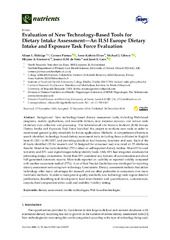Prikaz osnovnih podataka o dokumentu
Evaluation of New Technology-Based Tools for Dietary Intake Assessment-An ILSI Europe Dietary Intake and Exposure Task Force Evaluation
| dc.creator | Eldridge, Alison | |
| dc.creator | Piernas, Carmen | |
| dc.creator | Illner, Anne-Kathrin | |
| dc.creator | Gibney, Michael J. | |
| dc.creator | Gurinović, Mirjana | |
| dc.creator | de Vries, Jeanne | |
| dc.creator | Cade, Janet E. | |
| dc.date.accessioned | 2021-04-20T13:02:39Z | |
| dc.date.available | 2021-04-20T13:02:39Z | |
| dc.date.issued | 2019 | |
| dc.identifier.issn | 2072-6643 | |
| dc.identifier.uri | http://rimi.imi.bg.ac.rs/handle/123456789/938 | |
| dc.description.abstract | Background: New technology-based dietary assessment tools, including Web-based programs, mobile applications, and wearable devices, may improve accuracy and reduce costs of dietary data collection and processing. The International Life Sciences Institute (ILSI) Europe Dietary Intake and Exposure Task Force launched this project to evaluate new tools in order to recommend general quality standards for future applications. Methods: A comprehensive literature search identified technology-based dietary assessment tools, including those published in English from 01/2011 to 09/2017, and providing details on tool features, functions and uses. Each of the 43 tools identified (33 for research and 10 designed for consumer use) was rated on 25 attributes. Results: Most of the tools identified (79%) relied on self-reported dietary intakes. Most (91%) used text entry and 33% used digital images to help identify foods. Only 65% had integrated databases for estimating energy or nutrients. Fewer than 50% contained any features of customization and about half generated automatic reports. Most tools reported on usability or reported validity compared with another assessment method (77%). A set of Best Practice Guidelines was developed for reporting dietary assessment tools using new technology. Conclusions: Dietary assessment methods that utilize technology offer many advantages for research and are often preferable to consumers over more traditional methods. In order to meet general quality standards, new technology tools require detailed publications describing tool development, food identification and quantification, customization, outputs, food composition tables used, and usability/validity testing. | en |
| dc.publisher | MDPI, Basel | |
| dc.relation | International Life Sciences Institute (ILSI) Europe's Dietary Intake and Exposure Task Force | |
| dc.relation | National Institute for Health Research Collaboration for Applied Health Research (CLAHRC) | |
| dc.rights | openAccess | |
| dc.source | Nutrients | |
| dc.subject | dietary assessment | en |
| dc.subject | mobile technologies | en |
| dc.subject | Web-based technologies | en |
| dc.title | Evaluation of New Technology-Based Tools for Dietary Intake Assessment-An ILSI Europe Dietary Intake and Exposure Task Force Evaluation | en |
| dc.type | article | |
| dc.rights.license | ARR | |
| dc.citation.issue | 1 | |
| dc.citation.other | 11(1): - | |
| dc.citation.volume | 11 | |
| dc.identifier.doi | 10.3390/nu11010055 | |
| dc.identifier.fulltext | http://rimi.imi.bg.ac.rs/bitstream/id/735/935.pdf | |
| dc.identifier.pmid | 30597864 | |
| dc.identifier.scopus | 2-s2.0-85059275498 | |
| dc.identifier.wos | 000457474600007 | |
| dc.type.version | publishedVersion |

